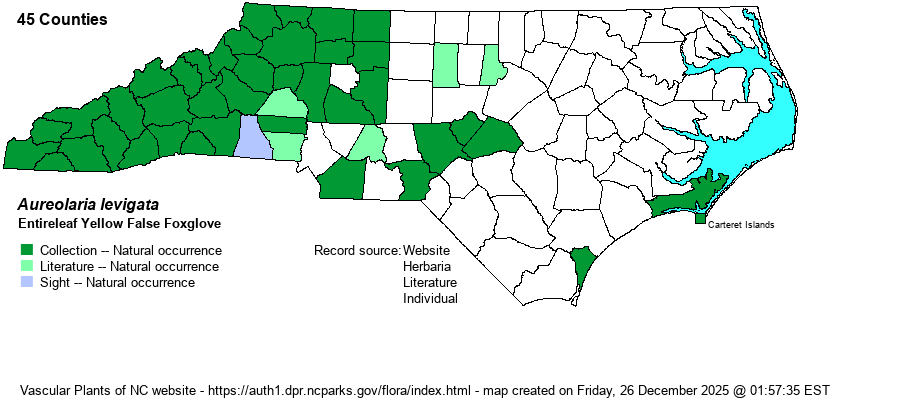| Author | (Rafinesque) Rafinesque | |
| Distribution | Present over the Mountains and the western 40% of the Piedmont; a few scattered records for the southeastern Piedmont; several records for coastal counties, highly disjunct from the rest of the range.
This is an Eastern species, ranging from PA and southern OH south to SC and GA, but very rare in the Coastal Plain. | |
| Abundance | Fairly common to common in the Mountains; fairly common in the western Piedmont, east to Stokes, Davidson, Lincoln, and Cleveland counties; rare southeast to Lee and Moore counties along the Fall Line. Casual along and very near the southern coast. | |
| Habitat | This is a species of upland oak and oak-hickory forests, often where somewhat rocky. It can occur into mesic stands on rocky slopes and near creeks (Harnett, Lee, Moore, and Richmond counties), but as it is a root parasite on oaks, it is not found in rich sites such as lower slopes and bottomlands. | |
| Phenology | Blooms in August and September, and fruits in September and October. | |
| Identification | This is a rather tall and wand-like herb, growing essentially without branches to about 3 feet tall, rarely to 4 feet tall. It has a smooth stem, with numerous pairs of opposite leaves. Unlike with the other four species in the genus in NC, this one has essentially only entire leaves (with no lobes); leaves are narrowly lanceolate, about 3 inches long and 2/3-inch wide, becoming smaller up the stem. Lowermost leaves are rather toothed or incised, but never to the degree of A. flava. The inflorescence is a terminal raceme, from leaf axils, such that the upper 6 inches of the plant are covered in large, bright yellow, bell-shaped flowers. Each flower reaches about 1.3 inches long and nearly as wide, about the same size and shape as on the other Aureolaria species. This is a reasonably widespread species in the western half of the state, and if you hike along upland hardwood trails in August and September you have a decent chance of seeing this entire, unlobed-leaved species, like others in the genus very showy and impossible to overlook when in bloom. | |
| Taxonomic Comments | Most references spelled it formerly, and still do, as Aureolaria laevigata.
| |
| Other Common Name(s) | Smooth Yellow False Foxglove | |
| State Rank | S3S4 [S4] | |
| Global Rank | G5 | |
| State Status | | |
| US Status | | |
| USACE-agcp | | |
| USACE-emp | | |

